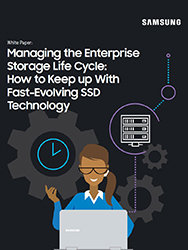As your data center and server rooms continue to mature and finish their migrations from overall hard disk drives (HDDs) and spinning media to some combination of solid state drives (SSDs) and other media, you may be wondering if drive manufacturers and the storage industry in general make differently equipped drives for implementing in different scenarios.
You’d be right: Samsung offers a complete line of enterprise class, data center intended solid state drives. From a drive with a great price point and value to drives where “no holds barred” performance is the first and only priority, there is a Samsung drive for every server and every data center. Here’s a closer look at the Samsung 883 DCT.
About the Drive
The 883 DCT was built as the next step in storage for data centers after enterprises upgrade from HDDs to SSDs and are ready to enhance capacity and performance. The drive is an enterprise-level SSD built to offer fast read/write speeds sustained over time, as well as protection against environmental problems, in a tight 2.5-in. form factor — an industry standard, making it compatible for direct attachment with the vast majority of servers both on the market and in production.
Notable features include:
- High read/write speeds. The drive has sequential read speeds of up to 560 MB/s and sequential write speeds of up to 520 MB/s, along with random read speeds of 98,000 I/O operations per second and random write speeds of up to 28,000 I/O operations per second, making for a performant drive that serves users, files and databases well.
- A range of capacities. The drive is available in a number of capacities including 240 GB, 480 GB, 960 GB, 1.9 TB and 3.8 TB, providing plenty of choices at different price points while also packing enough storage room for large volumes of files.
- Versatile storage medium. The 883 DCT includes Samsung’s latest V-NAND technology that helps to optimize read speeds, making this drive well suited for general purpose file or database servers. They’re designed operate in a 24×7 environment.
- Highly compatible form factor. The drive is available in the common 2.5-in. form factor, ensuring compatibility with servers from across the industry without purchasing expensive new servers, drive attach bays or accessories. It’s an easy upgrade within your existing infrastructure and can also be used well into the future as new servers come into your picture.
Manage the Enterprise Storage Life Cycle
Download this guide to improve your storage planning and evaluation processes. Download Now
More Than Size and Speed
- Power loss protection. The Samsung 883 DCT is able to prepare the SSD for unexpected system power loss by flushing out as much data in transit in temporary buffers as well. It also makes use of protection capacitors on the drive itself (think of these not as batteries, but as a very small “cache” of power or energy) to supply enough power for the SSD firmware to write data from any buffers directly to the NAND, thus protecting system and user data.
- Dynamic thermal guard protection. The Samsung dynamic thermal guard protection detects when the 883 DCT might be at risk of overheating and automatically scales back performance to thwart an involuntary shutdown — yet another way the drive prioritizes the protection of your system and your data.
The Samsung 883 DCT is a common sense choice for general server usage and makes an excellent entry point into server and data center class SSDs. For storage managers already deploying SSDs, the 883 DCT is a perfect next step up from the Samsung 860 DCT which comes in three capacity sizes.
Interested in learning more about which SSD is going to make the most sense for your data center needs? Take this quick assessment to find the best storage for your business.








